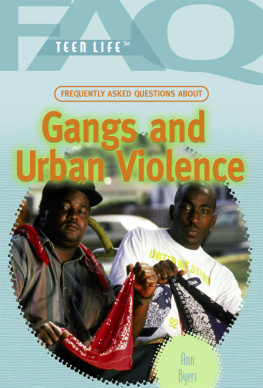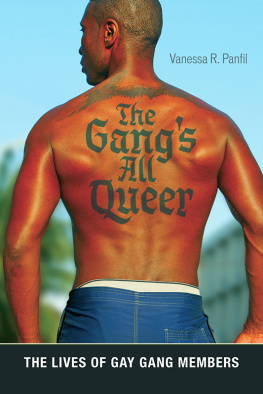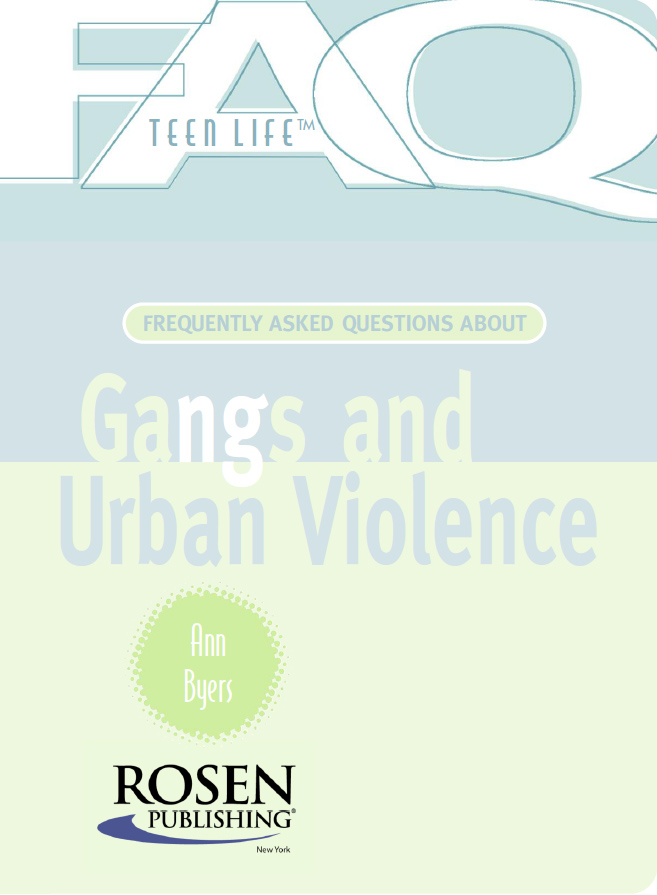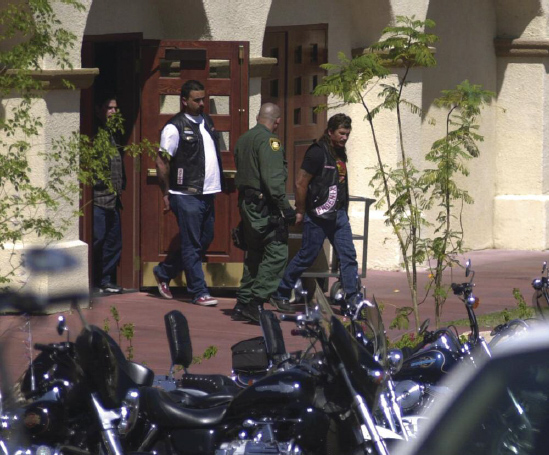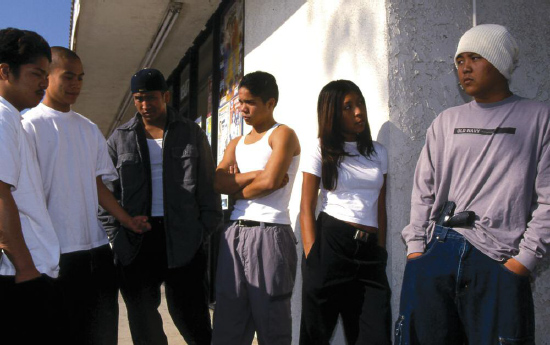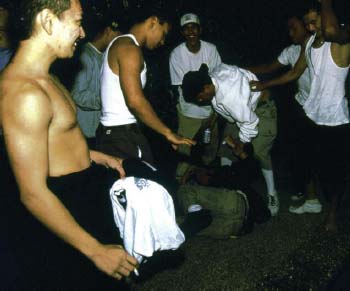Published in 2011 by The Rosen Publishing Group, Inc.
29 East 21st Street, New York, NY 10010
Copyright 2011 by The Rosen Publishing Group, Inc.
First Edition
All rights reserved. No part of this book may be reproduced in any form without permission in writing from the publisher, except by a reviewer.
Library of Congress Cataloging-in-Publication Data
Byers, Ann.
Frequently asked questions about gangs and urban violence / Ann Byers.
p. cm.(FAQ: teen life)
Includes bibliographical references and index.
ISBN 978-1-4488-1325-4 (library binding)
1. GangsUnited StatesJuvenile literature. 2. Urban violenceUnited StatesJuvenile literature. I. Title.
HV6439.U5B94 2011
364.10660973dc22
2010014523
Manufactured in the United States of America
CPSIA Compliance Information: Batch #W11YA: For further information, contact Rosen Publishing, New York, New York, at 1-800-237-9932.
Contents
What Is a Gang? Are There Different Types?
How Big Is the Gang Problem?
Who Joins a Gang? Why Do They Join?
What Kinds of Activities Are Gangs Involved In?
What Can Be Done About Gangs and Gang Violence?
Glossary
For More Information
For Further Reading
Bibliography
Index
Chapter one
WHAT IS A GANG? ARE THERE DIFFERENT TYPES?
The Shirttails, the Plug Uglies, and the Dead Rabbits. These were the names of some of the biggest gangs of early nineteenth-century America. Todays gangs have more violent monikers: Men of Destruction, Shotgun Crips, and Murder Squad.
Young people have always liked to hang together in groups. Sometimes they just have fun, and sometimes they cause trouble. When people talk about a gang, they usually mean a group of three or more people who:
Are together regularly and often
Identify themselves by a common name and symbols
See themselves as a gang and are recognized by others as a gang
Are street-oriented, which means their activities as a group are not done at home but on the streets or at other public places
Are engaged in criminal activities
Being involved in criminal activities is what sets a group apart as a gang. Some of the crimes are fairly minor, like damaging property, stealing, or spraying graffiti. Some are more serious, like auto theft, assault, or dealing in drugs. All of them can get people in trouble.
Three Kinds of Gangs
The Federal Bureau of Investigation (FBI) lists three types of gangs that cause serious problems. One is the outlaw motorcycle gang. These gangs are not motorcycle clubs but highly organized, extremely violent groups of adults who buy and sell guns and drugs. They are a big problem for law enforcement but not for most citizens; their violence is usually aimed at people directly involved in their criminal activities.
The second type of gang is the prison gang. As the name implies, these are networks of men in prisons. Many were in street gangs and were arrested and sentenced to prison for the crimes they committed in those gangs. They cannot directly harm ordinary citizens, but they do pose an indirect threat. While in prison, they recruit and train new members for their gangs. They also sometimes give orders to their gang friends on the outside, and those friends commit crimes in their neighborhoods. Furthermore, when they have finished serving their sentences, they almost always return to their gangs.
A police officer arrests two members of a motorcycle gang after a fight broke out during a motorcycle rally. Members of two rival gangs attacked one another with guns and knives, leaving some dead and wounded.
By far the biggest problem for policeand for everyone elseis the street gang. There are far more street gangs than any other type and many, many more people in street gangs than in outlaw motorcycle and prison gangs. Street gangs can be found in practically every city in the country and in many rural areas. Their members are on the streets and in the parks, schools, and jails of their communities.
Street Gangs
Traditional street gangs are groups of young people, mostly males, who live near each other. They are also called neighborhood gangs. They claim a certain turf, or geographic area, like a city block or set of blocks, as belonging to them. The main concern of turf-based gang members is controlling and defending their territory. They often pick fights with members of other gangs.
Turf gangs frequently evolve into gain-based gangs. These are groups that commit crimes for economic gain. They are usually involved in theft, robbery, or drug trafficking (buying and selling). The vast majority of gain-based gangs deal in drugs.
Turf-based gangs and drug gangs may look very similar, but there are some differences. Both groups commit a variety of crimes, but the crimes of turf-based gangs generally are against people in other gangs. Drug gangs commit more violent crimes against more people. Turf-based gangs compete for control of certain neighborhoods or blocks; drug gangs compete for control of the market for their goods. Turf-based gangs tend to have younger members and be more laid-back; drug gangs have older members and are deadly serious about what they do.
Some gangs are primarily or exclusively of one ethnic or racial group. That is because the neighborhood where they are located is made up mostly of one group. There are black gangs, white gangs, Hispanic gangs, and Asian gangs in black, white, Hispanic, and Asian neighborhoods.
Filipino gang members are hanging out in Long Beach, California. Note the gun in one members waistband. The oldest Filipino gang, the Santanas, began in the 1960s as a youth protection organization.
Many small street gangs want to tie themselves to larger, more well-known groups. They adopt their symbols and terms and call themselves sets or cliques of the bigger gangs. Members are called (collectively) a crew or a posse and (individually) gangbangers, bangers, homeboys, or homeys. Those who have pledged their allegiance form the core. Of these, the hard-core become leaders; they are the shot callers. Most gangs have people who are on the fringe, who are involved in some of the gangs activities but have not completely bought in. They are ripe for recruitment for full-fledged membership. Wannabes are usually younger kids in the neighborhood who want in; if they hang around long enough, they might be able to join.
Boys who want to be part of a gang beat up a boy on the street as part of an initiation. To be admitted to the gang, they have to prove they are tough and will follow the orders of the leader.
The Three Rs
The most important features of gang culture are the three Rs: reputation, respect, and retaliation. Reputation has to do with how people see the gang and its members. Members earn a good rep for themselves and their gang by being good at what the gang values. Usually that means fighting. Gangs want to be seen as tough. Members increase their reputation, also called juice and street cred (meaning credibility on the street), by beating up rivals, stealing cars or committing other crimes, and being sent to jail or juvenile hall.

